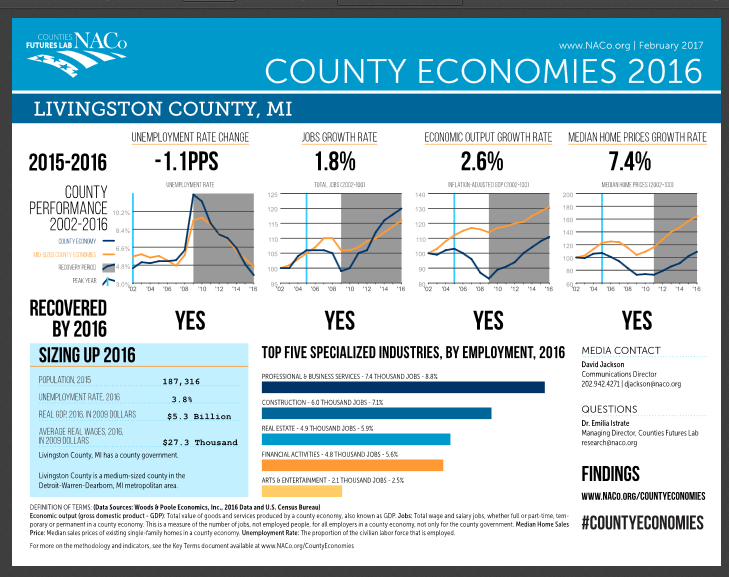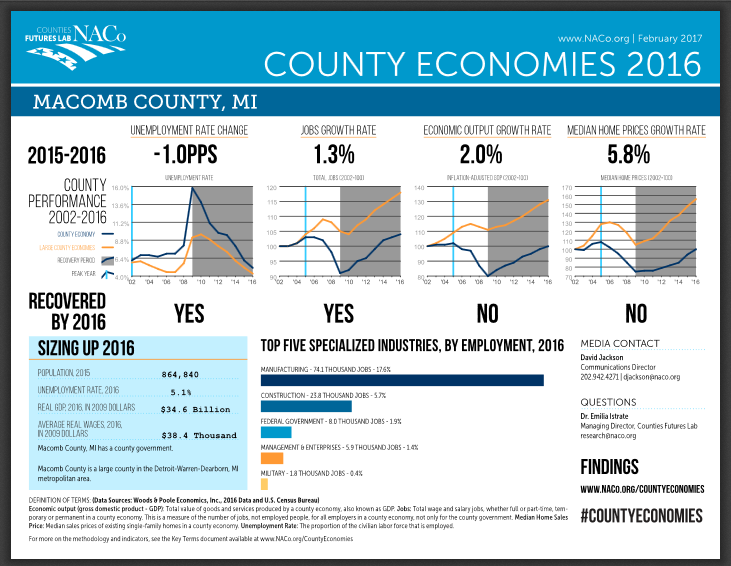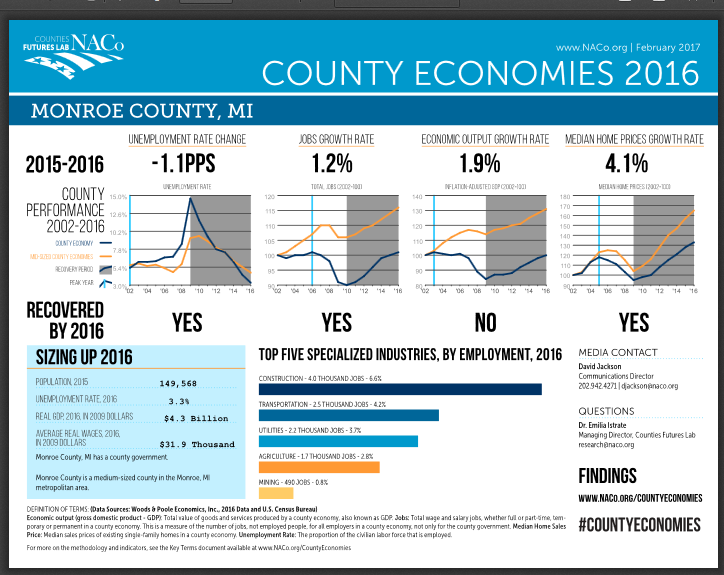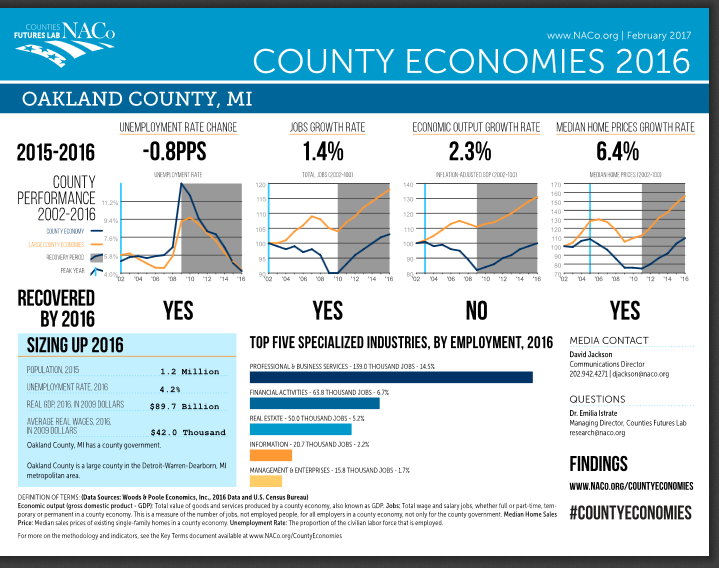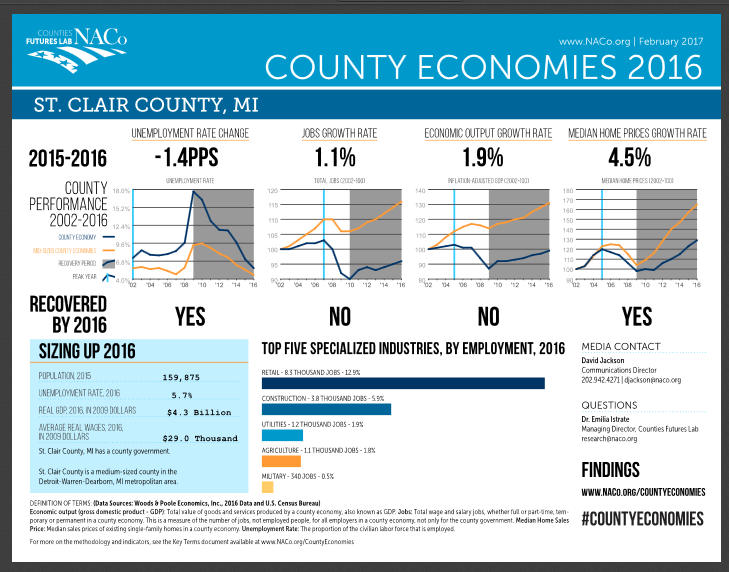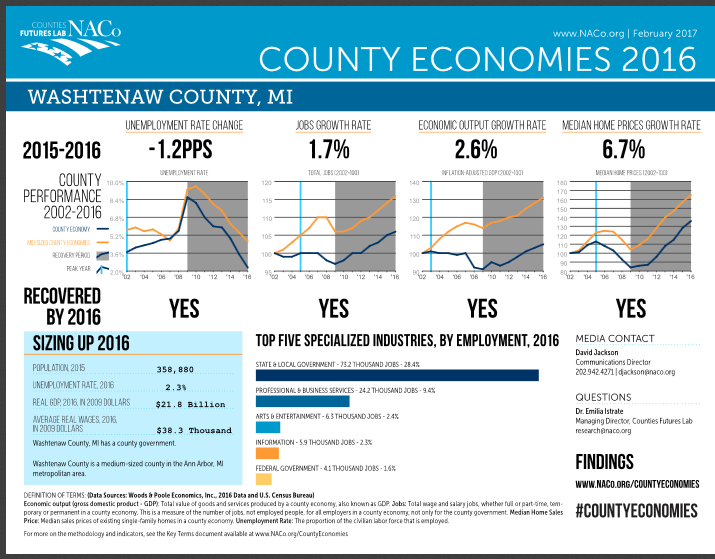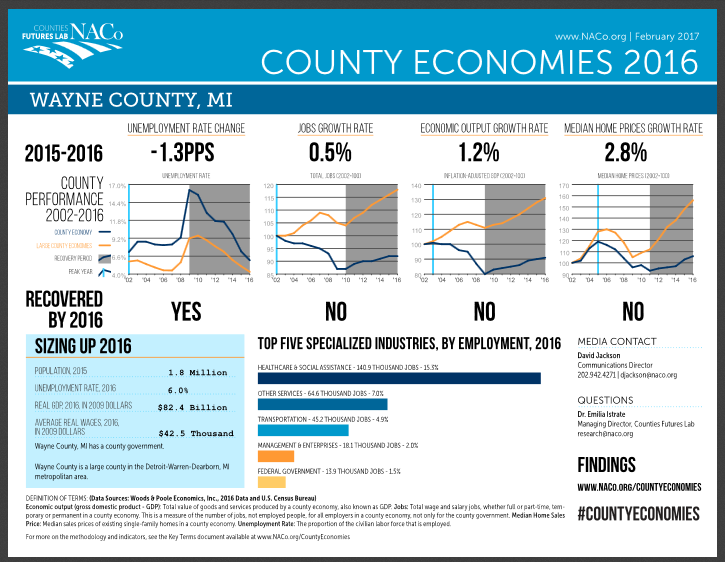According to four performance indicators, identified by the National Association of Counties (NACO), Southeastern Michigan has yet to fully recover from the recession. There are counties though, that are faring better than others, regionally. For example, Washtenaw County has recovered beyond it’s pre-recession peak recovery on all four performance indicators, while Wayne County has only overcome one of those peaks.
The four indicators NACO uses to determine county economic growth are:
- Unemployment Rate
- Job Growth (total number of jobs available)
- Economic output growth (Gross Domestic Product)
- Median Home Value Growth
To determine if there has been growth NACO first graphed annual values from 2002 to 2016 indicating which year between those two was the pre-recession peak (Or nadir, in the case of unemployment). If the 2016 value had not reached the pre-recession peak, which was typically 2005 for majority of the indicators for Southeastern Michigan, NACO deemed there to be no recovery in that area for that county.
Overall, the data shows that economic output recovery and median home values have been the slowest recovery throughout the region. Four the seven Southeastern Michigan counties have yet to experience pre-recession GDP values (adjusted for inflation) and two of the seven have yet to experience median home value recovery. All of the counties have had their unemployment rates drop to pre-recession numbers, or less.
According to NACO, Livingston County ranked in the highest section for economic recovery due to the fact that indicators showed job, unemployment, gross domestic product and home price recovery rates in 2016. For the total number of jobs available Livingston County’s pre-recession peak was in 2005, as was its GDP and median home price value. All three of these increased by 2016. The data also shows that between 2015 and 2016 the county’s unemployment rate dropped to 3.8 percent, which was a 1.1 percent decline from the previous year. Livingston County’s job growth rate increased by 1.8 percent, its economic output growth rate increased by 2.6 percent and its median home prices grew by 7.4 percent between 2015 and 2016.
The image below shows that Livingston County’s economic indicators have been showing signs of a stronger economy, however its economic output growth rate and its median home prices growth rate both fall below that of the average mid-sized county economies’.
None the less, there is job growth in Livingston County and the top five specialized industries in the county in 2016 were:
- Professional and business services
- Construction
- Real Estate
- Financial activities
- and Arts and Entertainment
Macomb County has only recovered in two of four performance areas to its pre-recession peaks, according to NACO. One of those two areas that experienced recovery is in job growth; the pre-recession peak was in 2005 and recovery began in 2009, and has continued to climb. Additionally, the unemployment rate was at 5.1 percent in 2016 is below the county’s 2002 pre-recession low point of 6.4 percent. The GDP peaked in 2005 by 2016 it had yet to climb back to the inflation adjusted number; however the county has experienced a steady increase since the 2009 low point. Median home values also have yet to reach the pre-recession peak in Macomb County, which was in 2005.
Between 2015 and 2016 Macomb County had a job growth rate of 1.3 percent, an economic output growth rate of 2 percent and a median home prices growth rate of 5.8 percent. Also, between 2015-16 the unemployment rate dropped 1 percent to 5.1 percent. While there has been economic growth in Macomb County, a look at the charts show that it has been slow and it remains below that of other large counties across the country.
With a job growth rate at 1.3 percent between 2015-16, the top five specialized industries in Macomb County by employment are:
- Manufacturing
- Construction
- Federal Government
- Management and Enterprises
- Military
By 2016 Monroe County experienced growth in three of the four performance indicators, according to NACO. While it experienced job, unemployment rate and home price recovery, its economic output growth rate was not considered favorable compared to pre-recession numbers. Monroe County’s GDP peaked in 2003 and by 2009 recovery had begun. However, in 2016 that recovery had yet to reach the 2003 inflation adjusted value, although it was close.
Also, according to NACO, between 2015 and 2016 Monroe County had a jobs growth rate of 1.2 percent, an economic output growth rate of 1.9 percent and a median home prices growth rate of 4.1 percent. The unemployment rate was at 3.3 percent in 2016, a 1.1 percent decrease from the prior year and a 2.2 decrease from 2002.
In Monroe County in 2016 the top five specialized job industries were:
- Construction
- Transportation
- Utilities
- Agriculture
- Mining
Similar to Monroe County, Oakland County only experienced economic growth in three of the four categories, according to NACO. Oakland County’s GDP has not recovered since its 2003 pre-recession peak; but like many of the other counties in the region recovery began in 2009. Between 2015 and 2016 though, Oakland County’s economic output growth rate did increase by 2.3 percent while its job growth rate rose by 1.4 percent and its median home prices growth rate went up by 6.4 percent. The annual unemployment rate in Oakland County decreased by .8 percent between 2015 and 2016 to a total of 4.2 percent. As has been seen by all the counties discussed thus far, Oakland County’s overall performance indicators remain below other large counties in the country.
In 2016 in Oakland County the top five specialized industries by employment were:
- Professional and business services
- Financial activities
- Real Estate
- Information
- Management and enterprises
In St. Clair County, total recovery has yet to be seen in both the job growth and economic output growth rate sections, according to NACO. In St. Clair County the total number of jobs available peaked in 2004 and in 2016 that number had yet to reach the pre-recession peak. However, there was a 1.1 percent jobs growth rate increase between 2015-16. Additionally, there was a 1.9 percent economic output growth rate between 2015-16. However, the GDP remained just below its 2005 peak. While those two areas have yet to recover, St. Clair County’s unemployment rate is below where it was at in 2002, its previous low point. In 2016 it had an unemployment rate of 5.7 percent, a decrease of 1.4 percent from the previous year. The county’s median home prices have also experienced growth. In 2016 the median home values had climbed above the previous 2005 peak. Additionally, between 2015-16 there was 4.5 percent increase.
St. Clair County’s top five specialized industries by employment are
- Retail
- Construction
- Utilities
- Agriculture
- Military
According to NACO, Washtenaw County has experienced economic growth across the board, with its unemployment rate dropping below 2002 rates and its job, economic output and median home price growth rates all rising above the 2005 values, the county’s previous peak values. In 2016 Washtenaw County had an unemployment rate of 2.3 percent, a 1.2 percent decrease from the previous year and also a decrease from its 2002 rate of 3.6. The county’s job growth rate grew 1.7 percent between 2015 -16. The economic output growth rate for Washtenaw County increased by 2.6 percent between 2015-16. Finally, the median home price growth rate increased by 6.7 percent between 2015-16. The top five specialized industries in Washtenaw County by employment are:
- State and local government
- Professional and business services
- Arts and entertainment
- Information
- Federal government
Wayne County is the only county in the region that has recovered in only one of the four areas, according to NACO. In 2002 Wayne County had an unemployment rate of 6.8 percent and in 2016 it was 6 percent, according to NACO. Since 2015 Wayne County has experienced positive growth rates for jobs, economic output and median home prices, but none have recovered to the pre-recession peaks. Wayne County’s unemployment rate was at its lowest in 2002 while the total number of jobs available was at its highest that year. Home values in the county peaked in 2005 and the GDP peaked in 2003.
While recovery has started in Wayne County, median home values and the total number of jobs available didn’t start to increase until 2010 or after, which is later than the 2009 recovery year many of the other counties in the experienced.
In Wayne County the top five specialized industries by employment:
- Healthcare and social assistance
- Other services
- Transportation
- Management and enterprises
- Federal government
